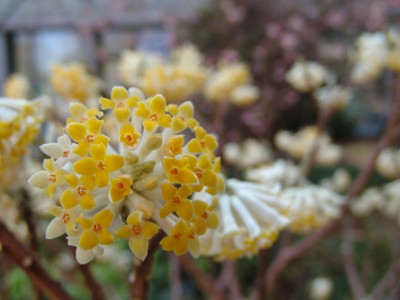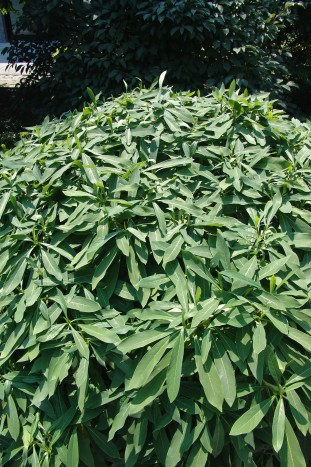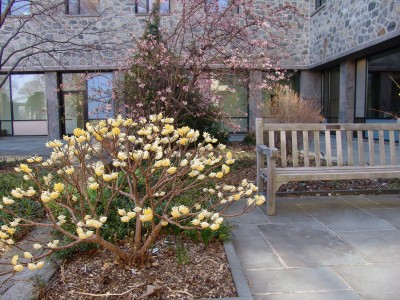Edgeworthia chrysantha
“Cutting edge” is a phrase, especially in the plant world, that is not easily defined. For the Scott Arboretum, it represents plants that are not very well known in public gardens, private gardens, and the horticulture trade.
I first saw Edgeworthia chrysantha growing at the state fairgrounds in Raleigh, North Carolina in 1993. We were being given a tour of the gardens and collections by Tony Avent, who now owns Plant Delights Nursery. It wasn’t until several years later that we added it to the collections at the Scott Arboretum. Many sources (i.e. catalogs, books, etc.) would lead you to believe that both Edgworthia chrysantha and E. papyrifera are not hardy in the Delaware Valley. After trialing both at the Scott Arboretum for 5 years, we have found both perfectly hardy.
This deciduous relative of Daphne forms a perfectly rounded shrub. Our best specimen is in the Cosby Courtyard where the stout stems form a dense head. This plant is 4 feet tall with a spread of nearly six feet. In the summer it is covered with long strap-like leaves which give it a somewhat tropical effect. Toward the end of summer the flower buds for the next spring are borne. They look like silver, silky spiders. As the leaves drop in the fall the flower buds are revealed and provide considerable winter interest. In late March to early April each bud opens revealing several tubular yellow flowers with a sweet fragrance.
We have several plants on campus, but the ones that perform the best are grown where they receive sun for most of the day. They thrive in soil that is rich in organic matter and does not dry out during periods of drought.
Just yesterday I received the Gossler Farms Nursery catalog. On page 11 was a plant I have coveted for years, Edgeworthia papyrifera ‘Red Dragon’. I first saw this plant growing at the Eisenhut Nursery near Ticino, Switzerland. Like E. chrysantha, it has early spring flowering clusters, but these are a vibrant reddish-orange. So, even though the catalog states “We have found E. p. ‘Red Dragon’ is more tender than E. papyrifera” given our past experience with supposedly tender plants this warrants inspection by the Scott Arboretum.
Learn more about “cutting edge” plant at the Scott Arboretum with me on Saturday, Oct. 11 from 9:30 am to 2 pm during our Horticulture Seminar: Cutting Edge Trees, Shrubs, and Vines.








Eva Monheim
Posted at 13:31h, 01 FebruaryWe have planted Edgeworthia at our arboretum at Temple University. This is the first winter for it in our newly planted winter garden and I am anxiously waiting to take pictures of the flowers when the weather gets a bit warmer. I am quite familiar with this plant after living in England and seeing it in the gardens around the University of Reading.
Julie B.
Posted at 00:23h, 14 MarchI planted an Edgeworthia Chrysantha about a year ago & it has “flowered” twice & has had a hand full of leaves (small tree). I cannot find any information about how fast/slow they normally grow, also how to fertilize & if I should trim to shape and when to do so. If I “deadhead” as flowers fade, will that encourage more flowering?
Thanking you in advance for your help!
Andrew Bunting
Posted at 10:36h, 30 MarchOur edgeworthias grow about 12-15″ per year. We have never pruned them and don’t really fertilize them. We do mulch around them with a combination of leaf compost and composted shredded bark. We have never deadheaded either and get a profusion of flowers every year.
Jean
Posted at 11:31h, 16 FebruaryWhen is the right time to move an edgworthia which has outgrown its space please
Andrew Bunting
Posted at 09:23h, 21 FebruaryI would think it is much easier to move an Edgeworthia when it is young than old. Like daphnes they have a not well formed root system and don’t lend themselves to moving very easily.
Katie
Posted at 21:10h, 04 MarchI’m look for Edgeworthia chrysantha. Does anyone know where I can find it? I’m in Delaware but can either travel or order. Thanks for the help!
Andrew Bunting
Posted at 16:01h, 07 MarchKatie,
Mostardi’s Nursery in Newtown Square, PA should have Edgeworthia.
Andrew Bunting, Curator
Jack Frost
Posted at 15:47h, 17 MarchHi, I bought my plant/ tree today, from a garden centre local to me. Newbank garden centre, Radcliffe Manchester , good luk
Florence Eliza Glaze
Posted at 10:03h, 05 NovemberI’ve just purchased an Edgeworthia chrysantha at the Duke University Gardens store in Durham, NC. Does anyone know the heat hardiness zone range for this plant, particularly whether it can take zone 9? Monrovia indicates on their website that it, like Daphne odora, is only zone 7-9, needing regular watering in warmer weather. I’m guessing also perhaps a little more shade.
Has anyone in zone 9 experience growing Edgeworthia? Thanks in advance for any reply.
Andrew Bunting
Posted at 10:55h, 05 NovemberI think Edgeworthia would be perfectly fine throughout the Southeastern states.
Andrew Bunting, Curator
Scott Arboretum
Julianna Chapman
Posted at 11:33h, 08 AprilDo you know the approximate root depth and strength? And would the roots eventually eat through a pipe?